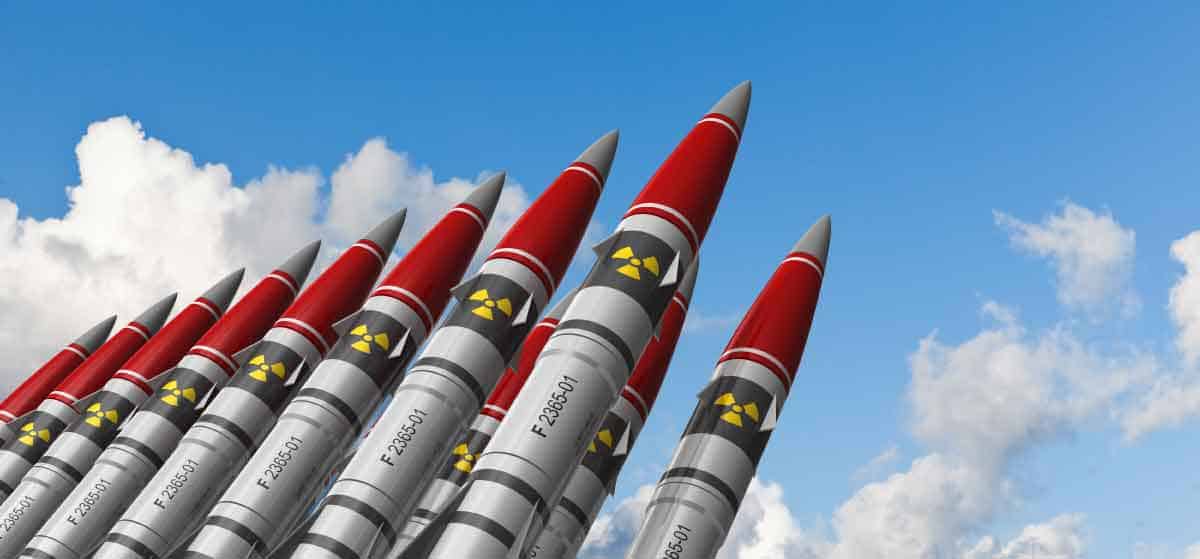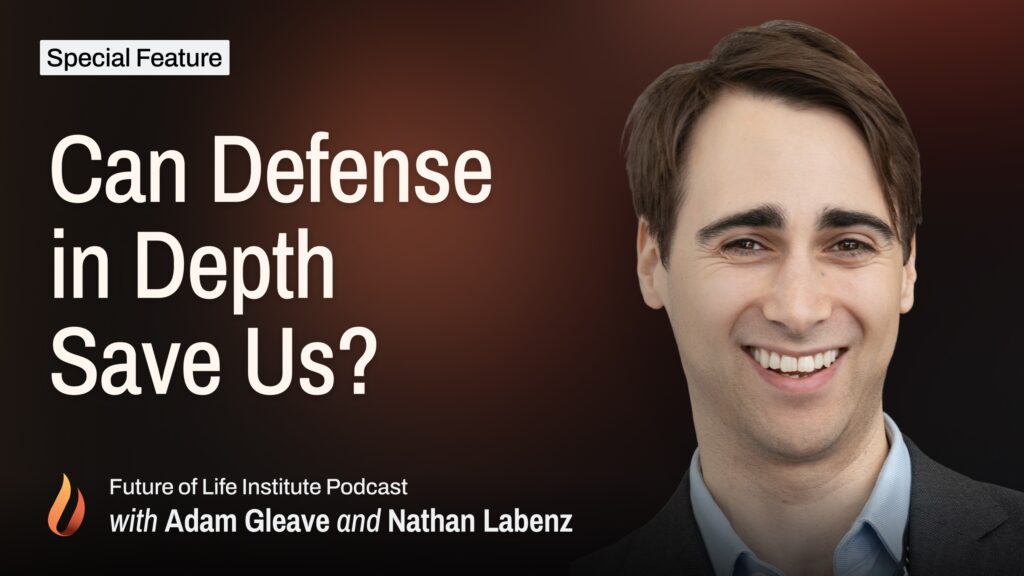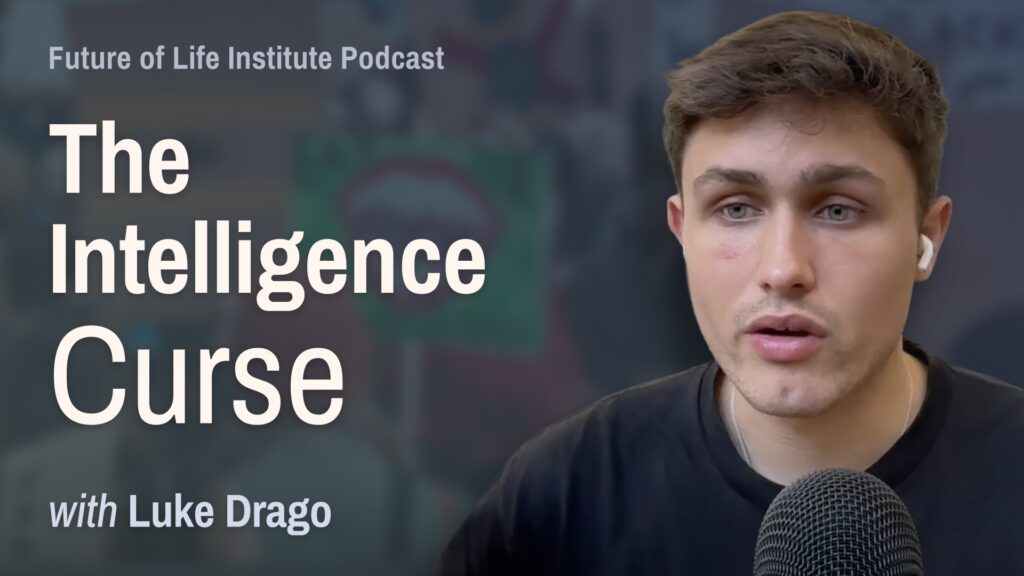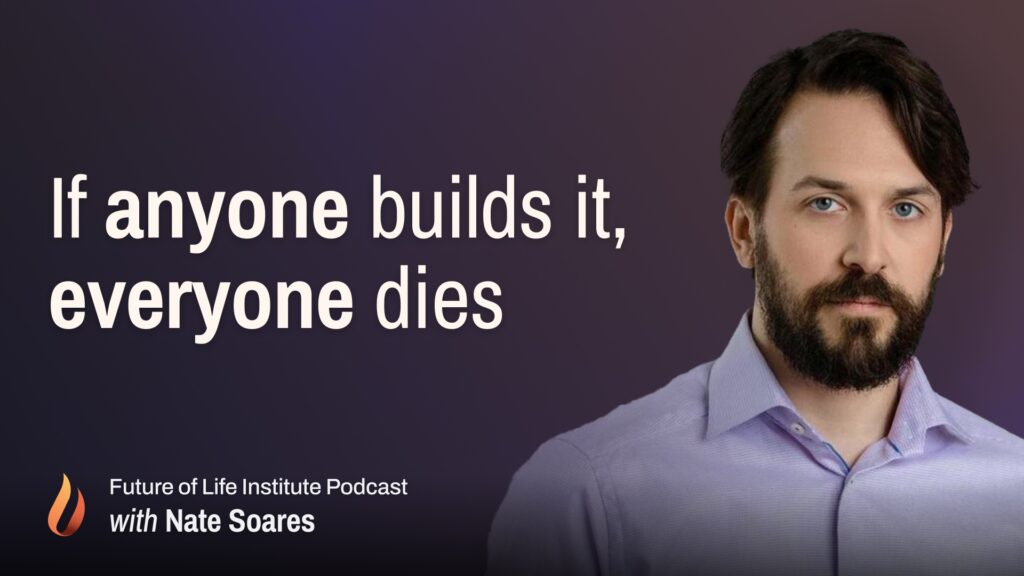Podcast: What Is Our Current Nuclear Risk?

A conversation with Lucas Perry about nuclear risk
Participants:
- Ariel Conn— Ariel oversees communications and digital media at FLI, and as such, she works closely with members of the nuclear community to help present information about the costs and risks of nuclear weapons.
- Lucas Perry—Lucas has been actively working with the Mayor and City Council of Cambridge, MA to help them divest from nuclear weapons companies, and he works closely with groups like Don’t Bank on the Bomb to bring more nuclear divestment options to the U.S.
Summary
In this podcast interview, Lucas and Ariel discuss the concepts of nuclear deterrence, hair trigger alert, the potential consequences of nuclear war, and how individuals can do their part to lower the risks of nuclear catastrophe. (You can find more links to information about these issues at the bottom of the page.)
Learn more about nuclear weapons in the 21st Century:
How many nuclear weapons are there and who has them?
What are the consequences of nuclear war?
What would the world look like after a U.S and Russia nuclear war?
How many nukes would it take to make the Earth uninhabitable?
What are the specific effects of nuclear winter?
What can I do to mitigate the risk of nuclear war?
Do we really need so many nuclear weapons on hair-trigger alert?
Transcript
Ariel: I’m Ariel Conn with the Future of Life Institute, and I’m here with Lucas Perry, also a member of FLI, to talk about the increasing risks of nuclear weapons, and what we can do to decrease those risks.
With the end of the Cold War, and the development of the two new START treaties, we’ve dramatically decreased the number of nuclear weapons around the world. Yet even though there are fewer weapons, they still represent a real and growing threat. In the last few months, FLI has gotten increasingly involved in efforts to decrease the risks of nuclear weapons.
One of the first things people worry about when it comes to decreasing the number of nuclear weapons or altering our nuclear posture is whether or not we can still maintain effective deterrence.
Lucas, can you explain how deterrence works?
Lucas: Sure, deterrence is the idea that to protect ourselves from other nuclear states who might want to harm us through nuclear strikes, if we have our own nuclear weapons primed and ready to be fired, it would deter another nuclear state from firing on us, knowing that we would retaliate with similar, or even more, nuclear force.
Ariel: OK, and along the same lines, can you explain what hair trigger alert is?
Lucas: Hair trigger alert is a Cold War-era strategy that has nuclear weapons armed and ready for launch within minutes. It ensures mutual and total annihilation, and thus acts as a means of deterrence. But the problem here is that it also increases the likelihood of accidental nuclear war.
Ariel: Can you explain how an accidental nuclear war could happen? And, also, has it almost happened before?
Lucas: Having a large fraction of our nuclear weapons on hair trigger alert creates the potential for accidental nuclear war through the fallibility of the persons and instruments involved with the launching of nuclear weapons, in junction with the very small amount of time actually needed to fire the nuclear missiles.
Us humans are known to be prone to making mistakes on a daily basis, and we even make the same mistakes multiple times. Computers, radars, and all of the other instruments and technology that go into the launching and detecting of nuclear strikes are intrinsically fallible, as well, as they are prone to breaking and committing error.
So there is the potential for us to fire missiles when an instrument gives us false alarm or a person—say, the President—under the pressure of needing to make a decision within only a few minutes, decides to fire missiles due to some misinterpretation of a situation. This susceptibility to error is actually so great that groups such as the Union of Concerned Scientists have been able to identify at least 21 nuclear close calls where nuclear war was almost started by mistake.
Ariel: How long does the President actually have to decide whether or not to launch a retaliatory attack?
Lucas: The President actually only has about 12 minutes to decide whether or not to fire our missiles in retaliation. After our radars have detected the incoming missiles, and after this information has been conveyed to the President, there has already been some non-negligible amount of time—perhaps 5 to 15 minutes—where nuclear missiles might already be inbound. So he only has another few minutes—say, about 10 or 12 minutes—to decide whether or not to fire ours in retaliation. But this is also highly contingent upon where the missiles are coming from and how early we detected their launch.
Ariel: OK, and then do you have any examples off the top of your head of times where we’ve had close calls that almost led to an unnecessary nuclear war?
Lucas: Out of the twenty-or-so nuclear close calls that have been identified by the Union of Concerned Scientists, among other organizations, a few that stand out to me are—for example, in 1980, the Soviet Union launched four submarine-based missiles from near the Kuril Islands as part of a training exercise, which led to a triggering of American early-warning sensors.
And even in 1995, Russian early-warning radar detected a missile launch off the coast of Norway with flight characteristics very similar to that of US submarine missiles. This led to all Russian nuclear forces going into full alert, and even the President at the time got his nuclear football ready and was prepared for full nuclear retaliation. But they ended up realizing that this was just a Norwegian scientific rocket.
These examples really help to illustrate how hair trigger alert is so dangerous. Persons and instruments are inevitably going to make mistakes, and this is only made worse when nuclear weapons are primed and ready to be launched within only minutes.
Ariel: Going back to deterrence: Do we actually need our nuclear weapons to be on hair trigger alert in order to have effective deterrence?
Lucas: Not necessarily. The current idea is that we keep our intercontinental ballistic missiles (ICBMs), which are located in silos, on hair trigger alert so that these nuclear weapons can be launched before the silos are destroyed by an enemy strike. But warheads can be deployed without being on hair trigger alert, on nuclear submarines and bombers, without jeopardizing national security. If nuclear weapons were to be fired at the United States with the intention of destroying our nuclear missile silos, then we could authorize the launch of our submarine- and bomber-based missiles over the time span of hours and even days. These missiles wouldn’t be able to be intercepted, and would thus offer a means of retaliation, and thus deterrence, without the added danger of being on hair trigger alert.
Ariel: How many nuclear weapons does the Department of Defense suggest we need to maintain effective deterrence?
Lucas: Studies have shown that only about 300 to 1,000 nuclear weapons are necessary for deterrence. An example of this would be, about 450 of these bombs could be located on submarines and bombers spread out throughout the world, with about another 450 at home on reserve and in silos.
Ariel: So how many nuclear weapons are there in the US and around the world?
Lucas: There are currently about 15,700 nuclear weapons on this planet. Russia and the US are the main holders of these, with Russia having about 7,500 and the US having about 7,200. Other important nuclear states to note are China, Israel, the UK, North Korea, France, India, and Pakistan.
Ariel: OK, so basically we have a lot more nuclear weapons than we actually need.
Lucas: Right. If only about 300 to 1,000 are needed for deterrence, then the amount of nuclear weapons on this planet could be exponentially less than it is currently. And the amount that we have right now is actually just blatant overkill. It’s a waste of resources and it increases the risk of accidental nuclear war, making both the countries that have them and the countries that don’t have them, more at risk.
Ariel: I want to consider this idea of the countries that don’t have them being more at risk. I’m assuming you’re talking about nuclear winter. Can you explain what nuclear winter is?
Lucas: Nuclear winter is an indirect effect of nuclear war. When nuclear weapons go off they create large firestorms from all of the infrastructure, debris, and trees that are set on fire surrounding the point of detonation. These massive firestorms release enormous amounts of soot and smoke into the air that goes into the atmosphere and can block out the sun for months and even years at a time. This drastically reduces the amount of sunlight that is able to get to the Earth, and it thus causes a significant decrease in average global temperatures.
Ariel: How many nuclear weapons would actually have to go off in order for us to see a significant drop in temperature?
Lucas: About 100 Hiroshima-sized nuclear weapons would decrease average global temperatures by about 1.25 degrees Celsius. When these 100 bombs go off, they would release about 5 million tons of smoke lofted high into the stratosphere. And now, this change of 1.25 degrees Celsius of average global temperatures might seem very tiny, but studies actually show that this will lead to a shortening of growing seasons by up to 30 days and a 10% reduction in average global precipitation. Twenty million people would die directly from the effects of this, but then hundreds of millions of people would die in the following months from a lack of food due to the decrease in average global temperatures and a lack of precipitation.
Ariel: And that’s hundreds of millions of people around the world, right? Not just in the regions where the war took place?
Lucas: Certainly. The soot and smoke from the firestorms would spread out across the entire planet and be affecting the amount of precipitation and sunlight that everyone receives. It’s not simply that the effects of nuclear war are contained to the countries involved with the nuclear strikes, but rather, potentially the very worst effects of nuclear war create global changes that would affect us all.
Ariel: OK, so that was for a war between India and Pakistan, which would be small, and it would be using smaller nuclear weapons than what the US and Russia have. So if just an accident were to happen that triggered both the US and Russia to launch their nuclear weapons that are on hair trigger alert, what would the impacts of that be?
Lucas: Well, the United States has about a thousand weapons on hair trigger alert. I’m not exactly sure as to how many there are in Russia, but we can assume that it’s probably a similar amount. So if a nuclear war of about 2,000 weapons were to be exchanged between the United States and Russia, it would cause 510 million tons of smoke to rise into the stratosphere, which would lead to a 4 degrees Celsius change in average global temperatures. And compared to an India-Pakistan conflict, this would lead to catastrophically more casualties from a lack of food and from the direct effects of these nuclear bombs.
Ariel: And over what sort of time scale is that expected to happen?
Lucas: The effects of nuclear winter, and perhaps even what might one day be nuclear summer, would be lasting over the time span of not just months, but years, even decades.
Ariel: What’s nuclear summer?
Lucas: So nuclear summer is a more theoretical effect of nuclear war. With nuclear winter you have tons of soot and ash and smoke in the sky blotting out the sun, but additionally, there has actually been an enormous amount of CO2 released from the burning all of the infrastructure and forests and grounds due to the nuclear blasts. After decades, once all of this soot and ash and smoke begin to settle back down onto the Earth’s surface, there will still be this enormous remaining amount of CO2.
So nuclear summer is a hypothetical indirect effect of nuclear war, after nuclear winter, after the soot has fallen down, where there would be a huge spike in average global temperatures due to the enormous amount of CO2 left over from the firestorms.
Ariel: And so how likely is all of this to happen? Is there actually a chance that these types of wars could occur? Or is this mostly something that people are worrying about unnecessarily?
Lucas: The risk of a nuclear war is non-zero. It’s very difficult to quantify exactly what the risks are, but we can say that we have seen at least 21 nuclear close calls where nuclear war was almost started by mistake. And these 21 close calls are actually just the ones that we know about. How many more nuclear close calls have there been that we simply don’t know about, or that governments have been able to keep a secret? We can reflect that as tensions rise between the United States and Russia, and as the risk of terrorism and cyber attack continues to rise, and the conflict between India and Pakistan is continually exacerbated, the threat of nuclear war is actually increasing. It’s not going down.
Ariel: So there is a risk, and we know that we have more nuclear weapons than we actually need for deterrence. Even if we want to keep enough weapons for deterrence, we don’t need as many as we have. I’m guessing that the government is not going to do anything about this, so what can people do to try to have an impact themselves?
Lucas: A method of engaging with this nuclear issue that has a potentially high efficacy is divesting. We have power as voters, consumers, and producers, but perhaps even more importantly, we have power over what we invest in. We have the power to choose to invest in companies that are socially responsible or ones which are not. So through divestment, we can take money away from nuclear weapons producers. But not only that, we can also work to stigmatize nuclear weapons production and our current nuclear situation through our divestment efforts.
Ariel: But my understanding is that most of our nuclear weapons are funded by the government, so how would a divestment campaign actually be impactful, given that the money for nuclear weapons wouldn’t necessarily disappear?
Lucas: The most important part of divestment in this area of nuclear weapons is actually the stigmatization. When you see massive amounts of people divesting from something, it creates a lot of light and heat on the subject. It influences the public consciousness and helps to bring back to light this issue of nuclear weapons. And once you have stigmatized something to a critical point, it effectively renders its target politically and socially untenable. Divestment also stimulates new education and research on the topic, while also getting persons invested in the issue.
Ariel: And so have there been effective campaigns that used divestment in the past?
Lucas: There have been a lot of different campaigns in the past that have used divestment as an effective means of creating important change in the world. A few examples of these are divestment from tobacco, South African apartheid, child labor, and fossil fuels. In all of these instances, persons were divesting from institutions involved in these socially irresponsible acts. Through doing so, they created much stigmatization of these issues, they created capital flight from them, and also created a lot of negative media attention that helped to bring light to these issues and show people the truth of what was going on.
Ariel: I know FLI was initially inspired by a lot of the work that Don’t Bank on the Bomb has done. Can you talk a bit about some of the work they’ve done and what their success has been?
Lucas: The Don’t Bank on the Bomb campaign has been able to identify direct and indirect investments in nuclear weapons producers, made by large institutions in both Europe and America. Through this they have worked to engage with many banks in Europe to help them to not include these direct or indirect investments in their portfolios and mutual funds, thus helping them to construct socially responsible funds. A few examples of these successes are A&S Bank, ASR, and the Cooperative Bank.
Ariel: So you’ve been very active with FLI in trying to launch a divestment campaign in the US. I was hoping you could talk a little about the work you’ve done so far and the success you’ve had.
Lucas: Inspired by a lot of the work that’s been done through the Don’t Bank on the Bomb campaign, in junction with resources provided by them, we were able to engage with the city of Cambridge and work with them and help them to divest $1 billion from nuclear weapons-producing companies. As we continue our divestment campaign, we’re really passionate about making the information needed for divestment transparent and open. Currently we’re working on a web app that will allow you to search your mutual fund and see whether not it has direct or indirect investments in nuclear weapons producers. Through doing so, we hope to not only be helping cities and municipalities and institutions divest, but also individuals like you and me.
Ariel: Lucas, this has been great. Thank you so much for sharing information about the work you’ve been doing so far. If anyone has any questions about how they can divest from nuclear weapons, please email Lucas at lucas@futureoflife.org. You can also check out our new web app at futureoflife.org/invest.
Related episodes

Can Defense in Depth Work for AI? (with Adam Gleave)

How We Keep Humans in Control of AI (with Beatrice Erkers)


